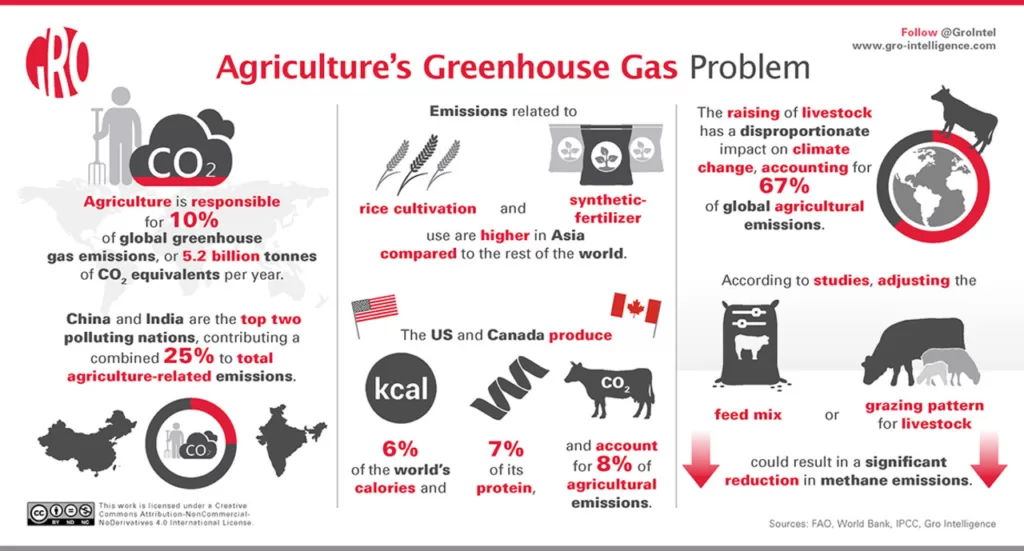Agriculture is a major source of greenhouse gas emissions, responsible for about 14.5% of global emissions. The main greenhouse gases emitted by agriculture are carbon dioxide (CO2), methane (CH4), and nitrous oxide (N2O).
CO2 is emitted through the use of fossil fuels in agriculture, such as gasoline for tractors and natural gas for irrigation. It is also produced as a result of soil management practices, such as tillage and the application of synthetic fertilizers.
Methane is produced by livestock during digestion and by the decomposition of organic matter in flooded rice paddies and manure storage facilities.
Nitrous oxide is emitted through the application of synthetic fertilizers and the management of animal manure. It is also produced during the decomposition of organic matter in soils.
There are several strategies that can be used to reduce greenhouse gas emissions from agriculture, including improving energy efficiency, adopting sustainable soil management practices, using precision agriculture techniques, and reducing food waste.
Agriculture is a major contributor to global greenhouse gas emissions, and reducing these emissions is essential for achieving global climate goals. This article will explore the challenges and opportunities for reducing greenhouse gas emissions in agriculture, and the potential for agricultural practices to help mitigate climate change.
Table of Contents
A. Overview of Greenhouse Gas Emissions in Agriculture
Agriculture is responsible for approximately 10-12% of global greenhouse gas emissions, with the majority of these emissions coming from livestock production and land use change. Livestock production is responsible for around 65% of agricultural emissions, while land use change accounts for around 25%. Other sources of agricultural emissions include fertilizer use, energy use, and waste management.
B. Strategies for Reducing Greenhouse Gas Emissions in Agriculture
Reducing agricultural emissions requires a comprehensive approach that includes both mitigation and adaptation strategies. Mitigation strategies focus on reducing emissions through improved management practices, such as improved fertilizer management, reduced tillage, and improved grazing management. Adaptation strategies focus on increasing the resilience of agricultural systems to climate change through improved water management, crop diversification, and improved soil health.
In addition, there are opportunities to increase the carbon sequestration potential of agricultural systems through agroforestry, cover crops, and other practices that increase soil organic matter. These strategies can help reduce emissions and increase the resilience of agricultural systems to climate change.
C. Need for Comprehensive Approach to Reduce Emissions
Reducing agricultural emissions requires a comprehensive approach that combines both mitigation and adaptation strategies. This approach must be tailored to the specific needs of each region and must take into account the economic and social realities of the local context. It is also important to consider the potential for agricultural systems to help mitigate climate change, through increased carbon sequestration and improved management practices.
Only by taking a comprehensive approach and considering all the factors involved can we effectively reduce greenhouse gas emissions in agriculture and help mitigate climate change.
II. Benefits of Reducing Greenhouse Gas Emissions in Agriculture
A. Improved Air Quality
Reducing agricultural emissions can help improve air quality by reducing the amount of pollutants released into the atmosphere. This can help reduce the health risks associated with air pollution, including respiratory and cardiovascular diseases.
B. Reduced Climate Change Impacts
Reducing agricultural emissions can also help reduce the impacts of climate change, such as increased temperatures, extreme weather events, and sea level rise. By reducing emissions, we can help slow the rate of climate change and reduce the severity of its impacts.
C. Increased Food Security
Reducing agricultural emissions can also help increase food security by improving soil health and increasing crop yields. Improved management practices, such as reduced tillage and improved fertilizer management, can help increase crop yields and reduce the need for additional land to be cleared for agriculture. This can help ensure that food production is sustainable and that there is enough food to meet the needs of a growing population.
B. Reduced Climate Change Impacts
Reducing agricultural emissions can also help reduce the impacts of climate change, such as increased temperatures, extreme weather events, and sea level rise. By reducing emissions, we can help slow the rate of climate change and reduce the severity of its impacts. Additionally, improved management practices can help reduce the risk of crop failure and other losses due to extreme weather events. This can help ensure that food production is sustainable and that there is enough food to meet the needs of a growing population.
C. Enhanced Soil Health
Reducing agricultural emissions can also help improve soil health by increasing the amount of organic matter in the soil. This can help improve soil fertility and water retention, which can lead to increased crop yields and reduced need for additional land to be cleared for agriculture. Improved soil health can also help reduce the risk of soil erosion and degradation, which can have a negative impact on agricultural productivity.
III. Strategies for Reducing Greenhouse Gas Emissions in Agriculture
A comprehensive approach to reducing greenhouse gas emissions in agriculture includes a variety of strategies, such as improved management practices, increased use of renewable energy sources, and adoption of new technologies.
A. Improved Management Practices
Improved management practices, such as reduced tillage and improved fertilizer management, can help reduce emissions and increase crop yields. Additionally, improved grazing management practices can help reduce methane emissions from livestock.
B. Renewable Energy Sources
Increasing the use of renewable energy sources, such as solar, wind, and geothermal, can help reduce emissions from agricultural operations. Additionally, renewable energy sources can help reduce the need for fossil fuels, which can help reduce air pollution and improve air quality.
C. New Technologies
Adopting new technologies, such as precision agriculture and precision livestock farming, can help reduce emissions and improve efficiency. Additionally, new technologies can help reduce the need for additional land to be cleared for agriculture, which can help reduce deforestation and improve soil health.
A. Improved Crop and Livestock Management
Improved crop and livestock management practices can help reduce emissions from agricultural operations. Additionally, these practices can help improve crop yields and reduce the need for additional land to be cleared for agriculture. Improved management practices can also help farmers adapt to climate change.
B. Increased Use of Renewable Energy
Increasing the use of renewable energy sources can help reduce emissions from agricultural operations. Renewable energy sources can also help reduce the need for fossil fuels, which can help reduce air pollution and improve air quality. Additionally, renewable energy sources can help reduce the cost of energy for agricultural operations.
Adopting new technologies, such as precision agriculture and precision livestock farming, can help reduce emissions and improve efficiency. Additionally, new technologies can help reduce the need for additional land to be cleared for agriculture, which can help reduce deforestation and improve soil health.
IV. Conclusion
Reducing greenhouse gas emissions in agriculture requires a comprehensive approach that includes improved management practices, increased use of renewable energy sources, and adoption of new technologies. Improved management practices can help reduce emissions and increase crop yields, while renewable energy sources can help reduce the need for fossil fuels and reduce air pollution. New technologies can also help reduce emissions and improve efficiency, while reducing the need for additional land to be cleared for agriculture.
A. Summary of Benefits of Reducing Greenhouse Gas Emissions in Agriculture
Reducing greenhouse gas emissions in agriculture can help reduce air pollution, improve crop yields, reduce the need for additional land to be cleared for agriculture, and improve soil health. Additionally, renewable energy sources can help reduce the cost of energy for agricultural operations.
Reducing greenhouse gas emissions in agriculture requires a comprehensive approach that includes improved management practices, increased use of renewable energy sources, and adoption of new technologies. This approach can help reduce emissions, improve crop yields, reduce the need for additional land to be cleared for agriculture, and improve soil health.
B. Call to Action for Farmers and Policymakers
Farmers and policymakers should take action to reduce greenhouse gas emissions in agriculture. Farmers should adopt improved management practices, increase the use of renewable energy sources, and adopt new technologies to reduce emissions and improve efficiency. Policymakers should create incentives for farmers to reduce emissions and support the adoption of new technologies. Additionally, policymakers should create policies that promote the use of renewable energy sources and reduce the use of fossil fuels.
By taking action to reduce greenhouse gas emissions in agriculture, farmers and policymakers can help reduce air pollution, improve crop yields, reduce the need for additional land to be cleared for agriculture, and improve soil health. This comprehensive approach can help create a more sustainable and resilient agricultural sector, which can benefit both farmers and the environment.







